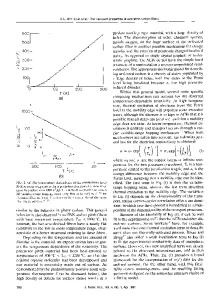Characterization of Activated Carbon Fibers
- PDF / 400,581 Bytes
- 6 Pages / 420.48 x 639 pts Page_size
- 96 Downloads / 390 Views
CHARACTERIZATION OF ACTIVATED CARBON FIBERS A. W. P. FUNG', A. M. RAO", K. KURIYAMA", M. S. DRESSELHAUS',**, G. DRESSELIIAUSI AND M. ENDOt
* Department of Electrical Engineering, Massachusetts Institute of Technology, Cambridge, MA ** Department of Physics, Massachusetts Institute of Technology, Cambridge, MA SFrancis Bitter National Magnet Laboratory, Massachusetts Institute of Technology, Cambridge, MA I Faculty of Engineering, Shinshu University, Nagano, Japan
Abstract Low-temperature electrical conductivity and Raman scattering are studied as characterization tools for activated carbon fibers, which have a high density of defects and a huge specific surface area. The transport mechanism at low temperature is governed by variablerange hopping, as in other strongly disordered systems. From the Raman spectra obtained, we deduce that the long phenolic fibers are more disordered than the acrylic fibers and that increased specific surface area corresponds to increased disorder. The average in-plane microcrystallite size is about 20-30 A.
Introduction Although the adsorption properties of activated carbons have been extensively studied, there has been little work done on other physical properties of this interesting material, which possesses an unusally high density of defects and a huge specific surface area (SSA), exceeding that in other solids. The recent success in the fabrication of activated carbon fibers (ACFs) allows the transport properties of this disordered material to be investigated. Di Vittorio [11 has made a preliminary survey of the temperature dependence of the dc electrical conductivity, the magnetoresistance, the thermal conductivity and the thermopower of acrylic ACFs with specific surface area (SSA) of 1000 rn 2/g. The dc conductivity and the photoconductivity were studied by Kuriyama and Dresselhaus 121over a temperature range of -• 30K < T < 300K for phenolic ACFs with SSAs ranging from 1000m,/g to 2000m 2/g. The conduction mechanism in disordered solids is generally known to be governed by hopping. Measurement of the electrical conductivity down to temperatures lower than 30 K has been used to identify the hopping conduction model to be used in interpreting the photoconductivity and the magnetoresistance data at higher temperature. A comprehensive understanding of the various transport phenomena should be essential to learning the nature of defects and the role they play in transport. Some knowledge of the microstructure of ACFs can also be obtained from the Raman scattering experiments and such knowledge should help our understanding of the conduction mechanism. It is also interesting to see whether both low-temperature conductivity measurements and Raman scattering can be used as complementary characterization tools for ACFs.
Experimental Details The precursor materials of the ACFs we studied are isotropic pitch (acryl) and phenol. The SSA ranges from 1000 m 2 /g to 3000rn'2 /g for the acrylic ACFs and from 1000n 2 /g to 2000m 2 /g for the phenolic ones. The precursor is first spun to for
Data Loading...











